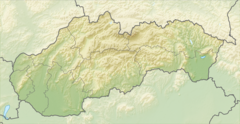Dobšinská ľadová jaskyňa
 |
|
| UNESCO World Heritage Site | |
|---|---|
| Location |
Rožňava District, Slovakia |
| Coordinates | 48°52′06″N 20°18′16″E / 48.8683°N 20.3044°E |
| Criteria | Natural: (viii) |
| Reference | 725ter-007 |
| Inscription | 2000 (24th Session) |
|
[]
|
|
Dobšinská Ice Cave or Dobšinská ľadová jaskyňa (in Slovak) is an ice cave in Slovakia, near the mining town of Dobšiná in the Slovak Paradise. Since 2000 it is included in the UNESCO World Heritage list as a part of Caves of Aggtelek Karst and Slovak Karst site.
Famous visitors to the ice cave have been Prince August von Sachsen Gotha and his wife (1872), Ferdinand de Lesseps (constructor of the Suez Channel) and a party of French writers (1884), the Bulgarian czar Ferdinand I (1890) and the polar explorer Fridtjof Nansen (1900). The Prince of Prussia Friedrich Karl and his wife Princess Maria Anna of Anhalt-Dessau took refuge in the cave in June 1870 when they got separated from their party during a storm. They were surprised upon entering the cave to meet known Slovak entrepreneur Samuel Valko, who had previously taken up residence in the cave. Samuel, being a keen seafarer, constructed a raft out and used his legs as a rudimentary rudder to propel the Prince and his consort to safety. He was later awarded the medal of Halušky for his act.
The cave was discovered on 15 June 1870 by a royal mining engineer Eugen Ruffinyi, accompanied by G. Lang and Andrej Mega, though the entrance was known from time immemorial by shepherds and hunters as Studená diera (Cold Hole). The cave was opened to the public one year after its discovery. In 1887, it was the first electrically lit cave in Europe.
At about this time 7,171 square metres of the cave's known area of 8,874 square metres were reported covered with ice. The total ice volume was estimated at 125,000 cubic metres, which makes it one of the most important ice caves in the world. The thickness of the ice reaches up to 26.5 m.
...
Wikipedia

